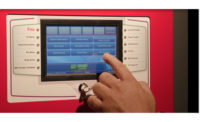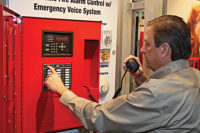Commercial fire alarm panels traditionally have not been one of the most dynamic product development areas within the security industry — a situation that has arisen, some say, because of heavy code requirements. In recent years, however, fire alarm panel manufacturers have introduced several new capabilities that can save business customers money, enhance system performance, and even generate new recurring monthly revenue (RMR).
At least two manufacturers — Northford, Conn.-based Notifier and St. Louis-based Potter Electric Signal — have added the ability to interface with building control systems. As Jeff Hendrickson, vice president of fire and security product development for Potter Electric Signal explains, this capability allows fire alert information to flow through into a building control system. “The guard wants to know what to do,” Hendrickson explains. “The information tells the guard who to call.”
Potter has worked or is in the process of working with about half a dozen manufacturers of building control and other systems to define interfaces between Potter’s fire panels and the other systems.
Notifier also has developed interfaces to building control and other systems, notes John Terrell, strategic product manager for the manufacturer. “We’re starting to see a trend develop where manufacturers are starting to coalesce around certain protocols,” Terrell explains. “It allows you to communicate beyond your own network.”
Notifier has worked to develop gateways that enable fire panels to communicate with other types of systems that use several different communications protocols. For example, gateways are available for the Modbus protocol used in process control systems, for the BACnet protocol used in building management systems, and for the common alerting protocol (CAP) used in distributed recipient mass notification systems (DRMNS). The latter are designed to send emergency alerts via email, text messaging, computer pop-ups and other methods, Terrell explains. (See “Mass Notification Drives New Fire Panel Capabilities” on page 70.)
“We communicate with them when you have a fire or other event on our system,” notes Terrell. The DRMNS then delivers that information to appropriate parties using whatever methods have been specified.
As more and more fire panels rely on the Internet protocol for communications, at least one fire panel manufacturer has developed new ways to leverage IP to unleash a new capability that has strong appeal to some customers — the ability to automatically send fire alarms and alerts to the customer via email. Some central stations offer this capability through their automation systems, but Potter has that capability built-in to the panel. This approach enables the panel itself to send the information over a data network connection to a remote server operated by Potter, which then sends the email alert to the customer. Potter does not charge dealers for this capability, but Hendrickson notes that some customers may opt to charge customers for it, thereby generating a new RMR stream.
Hendrickson cautions, however, that the email alerts cannot replace 24-hour central station monitoring, which is a code requirement for commercial fire systems.
Kentec Electronics, the fire panel manufacturer acquired by Hochiki, soon plans to release a fire panel in the United States that supports email capability via a data network connection to a remote server, operated in this case by Kentec. With Kentec’s system, dealers have the option of emailing the customer a photo of the technician who will be coming to do the inspection, notes Jay Cohen, director of engineering and application development for Hochiki’s VES Fire Protection unit, based in King of Prussia, Pa.
Potter and some other manufacturers also use an IP connection to the fire panel to enable dealers to “interrogate” the panel to enhance their ability to service the customer. For example, technicians can gather information about the panel prior to a regularly scheduled inspection so that they can plan to take any steps necessary to ensure that the system will be able to pass the inspection.
Another important trend is that fire panels increasingly are using two different forms of wireless communications — short-range wireless for transmissions between the panel and wireless sensors, and digital cellular communications between the panel and the central station.
As Lew Kramer, applications solution designer for Springfield, Mo.-based manufacturer Digital Monitoring Products, explains, short-range wireless communications for fire alarm systems has become more practical now that those systems can support two-way communications. Traditionally, fire panels met three-minute supervision requirements by repeatedly sending test signals every three minutes — the idea being that by using multiple transmissions, there would be a high level of confidence that one or more of those signals would get through, notes Kramer. The downside was that this approach can quickly drain batteries, requiring large batteries and/or frequent battery replacement.
Systems with two-way communications use a return transmission to confirm that a test signal has been received, thereby minimizing the number of times the test signal must be sent and reducing battery requirements, Kramer observes.
Digital cellular communications to the central station offer an alternative to the redundant phone lines traditionally used for fire panels, which can reduce the customer’s monthly communications costs substantially. These systems work over a cellular data connection, and because they consume only small amounts of airtime, it is practical for them to check in every five minutes. That approach is a substantial improvement over the dual-phone-line approach, which can take up to 24 hours to alert the central station of such a failure, Kramer notes.
The National Fire Protection Association has approved digital cellular communicators from several fire panel manufacturers as the sole communications method for commercial fire installations. Kramer cautions, however, that “some AHJs still have some issues” with cellular-only solutions.
Mass Notification Drives New Fire Panel Capabilities
Tragic shootings at schools and in other public places are driving increased interest in mass notification systems; fire panels can play a key role in those systems.
Mass notification first found its way into the National Fire Protection Association codes as an addendum to the 2007 version of the NFPA72 code, says Ted Milburn, vice president of marketing for Cooper Notification, a Sarasota, Fla.-based manufacturer of notification systems.
That addendum describes how a mass notification system should work, but stops short of requiring such a system, instead leaving it up to local authorities to set requirements for their own jurisdictions. The 2010 and 2013 versions of the code move mass notification out of an addendum and into the main text, but continue to leave the decision about whether to require mass notification up to local authorities, Milburn explains.
To date, Milburn says relatively few authorities having jurisdiction (AHJs) have opted to mandate mass notification capability. Nevertheless, he says some customers, especially schools, are voluntarily installing mass notification because they believe it is important to have.
Many business customers are conducting risk assessments to determine the types of mass notification that could be useful to them and are installing notification systems that can help address their specific situation, notes Jason Falbo, vice president of engineering for Summit Systems Technologies, a Toronto-based manufacturer that is one of the Mircom Group of Companies. Falbo adds that mass notification is a requirement for deployments at U.S. military facilities.
Mass Notification Options
Depending on the risks involved, an AHJ may require any of the various notification methods. One potential requirement is automatic sending of emails, computer screen pop-ups, or other alerts to those who are likely to be in the vicinity of the emergency — students on a campus, employees at a manufacturing facility, etc. A distributed-recipient mass notification system (DRMNS) is typically used to control this capability.
Other notification methods that may be required include the ability to broadcast pre-programmed or live instructions over an audio system and visual alerts via electronic signs and special dual strobes. As Roopa Shortt, audible visible marketing manager for St. Charles, Ill.-based manufacturer System Sensor explains, one of the strobes in the dual strobe is marked “fire” and has a clear lens, while the other is marked “alert” and is amber.
Shortt argues that multiple notification methods are a good idea in an era when recipients are likely to ignore a single email alert, believing it to be just one more spam message. She adds that email, Twitter and the like cannot be the prime notification method; they must be one of many methods.
The Role of the Fire Panel
Fire alarm panels can play a key role in meeting several important mass notification requirements. First, because fire panels are already designed to drive sounders and strobes, they are a logical choice to adapt the panels so that they can send emergency information and alerts to those devices and to other equipment such as electronic signs or paging systems. Shortt says, though, that while fire systems traditionally would use horns, a system supporting mass notification will need to use speakers. Those speakers must be able to meet new intelligibility mandates, which require that the speakers can be understood by people in their vicinity — and as Milburn notes, not all fire panels can drive speakers in an intelligible manner. If the panel is “not capable of generating quality sound, it doesn’t matter what kind of speaker you put on it,” he observes.
Depending on the specific installation, fire panels also may need to interface with DRMNS. Cooper Notification offers a DRMNS that integrates with fire panels from several different manufacturers via an application programming interface, Milburn notes. And John Terrell at Notifier says the company offers a fire panel that communicates with DRMNS that support the common alerting protocol.
Another important requirement of today’s mass notification systems that impacts fire panel design is that mass notification must be able to take priority over a fire alert. As Bosch Security Systems Product Marketing Manager Mark Andersen explains, it is not unusual for people to activate fire alarm pull stations in an emergency as a means of drawing attention to the emergency. But loud fire alarms can hamper people’s ability to hear instructions from the paging system.
According to Andersen, many fire panel manufacturers are still working on how to design their panels to meet this requirement. He notes that Bosch is working on an emergency control panel that would connect one or more fire panels to a customer’s public address system and would have the ability to override the fire panel’s commands to the sounders. Until products such as these are more widely available, Andersen says some AHJs are allowing installations to meet fire alarm shut-off requirements by having security personnel manually override the sounders.
Any security dealers that do commercial fire work but have not yet installed a commercial fire system requiring mass notification capability should consider learning more about the technology. Milburn believes mass notification “gains traction” with every new version of the NFPA code.
This article was originally published in the print magazine as "More Value, Power From Today’s Fire Panels."







